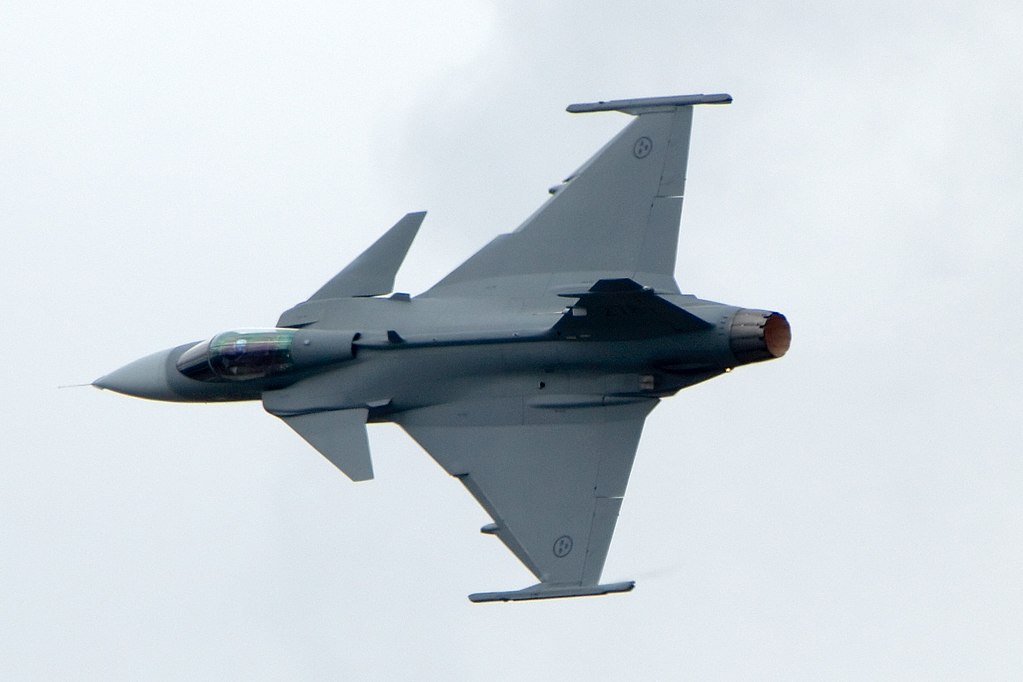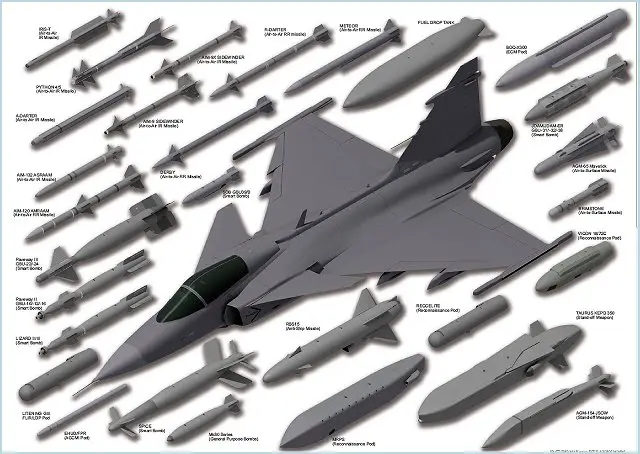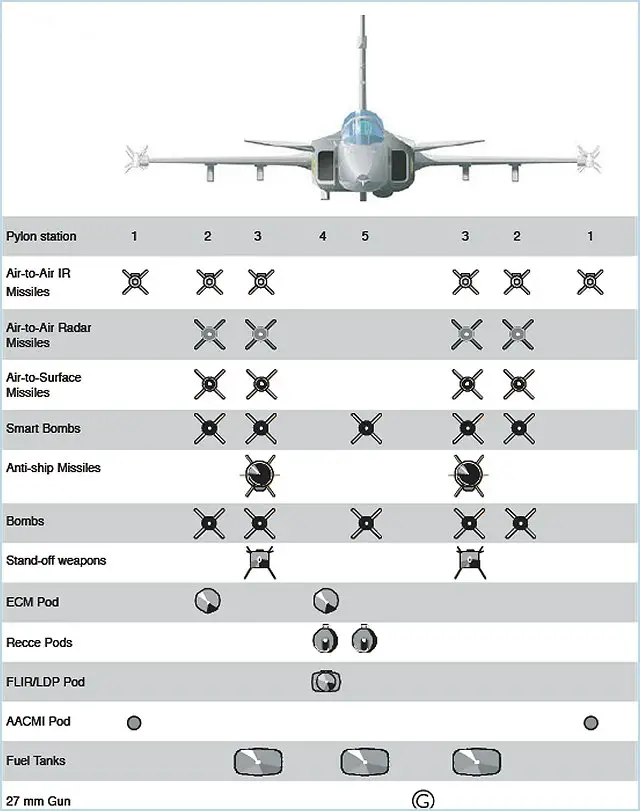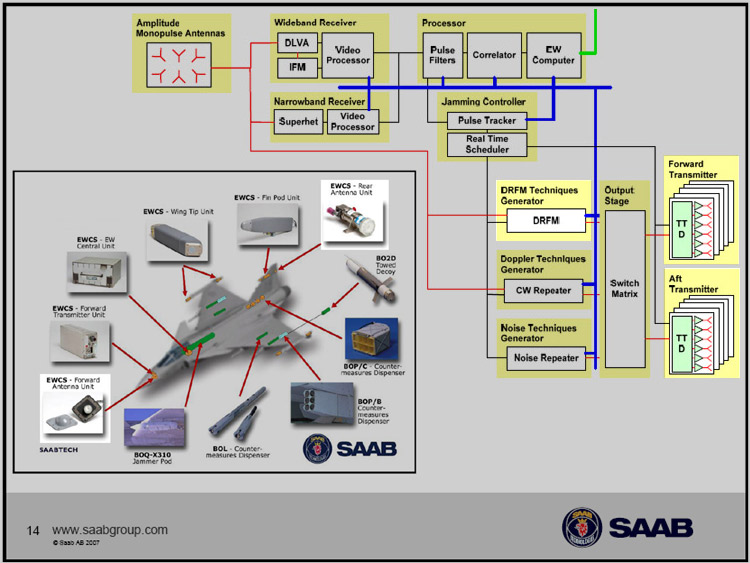The Saab JAS 39 Gripen (English: "griffin") is a light single-engine multirole fighter aircraft developed by Saab, was first flown in December 1988 and entered operational service with the Swedish Air Force in 1997. It is planned that the Gripen will replace all current variants of the Viggen and Draken combat aircraft.
The Gripen has a delta wing and canard configuration with relaxed stability design and fly-by-wire flight controls. It is powered by the Volvo RM12, and has a top speed of Mach 2. Later aircraft are modified for NATO interoperability standards and to undertake in-flight refuelling.
Gripen has been developed by an industrial consortium consisting of Saab, Saab Microwave Systems (formerly Ericsson), Volvo Aero Corporation, Saab Avitronics and FFV Aerotech. A joint venture company, Gripen International, has been set up by Saab and BAE Systems to market the Gripen for export markets. BAE Systems is building the main landing gear unit and wing attachment unit.
Gripen is a new generation, multi-role fighter aircraft which uses state-of-the-art technology. It is capable of performing an extensive range of Air-to-Air, Air-to-Surface and reconnaissance missions employing the most modern range of weapons. Gripen is designed to meet the demands of current and future threats, while at the same time meeting strict requirements for flight safety, reliability, training efficiency and low operating costs. The Gripen fighter is in service with a number of air forces: Swedish, Czech Republic and Hungarian Air Forces and has also been ordered by the South African Air Force and the Royal Thai Air Force. The UK Empire Test Pilots’ School (ETPS) is operating Gripen as its advanced fast jet platform for test pilots worldwide. Gripen is NATO compatible and globally interoperable meeting the most demanding operational requirements and has now accumulated well over 100,000 flight hours. A two-seat version of the Gripen, which retains the full operational capability of the single-seater, is also available for tactical weapons training, more specialized missions and type conversion.
Development
In 1979, the government began a study calling for a versatile platform capable of "JAS", standing for Jakt (air-to-air), Attack (air-to-surface), and Spaning (reconnaissance), indicating a multirole, or swingrole, fighter aircraft that can fulfill multiple roles during the same mission. Several Saab designs were reviewed, the most promising being "Project 2105" (redesignated "Project 2108" and, later, "Project 2110"), recommended to the government by the Defence Materiel Administration (Försvarets Materielverk, or FMV). In 1980, Industrigruppen JAS (IG JAS, "JAS Industry Group") was established as a joint venture by Saab-Scania, LM Ericsson, Svenska Radioaktiebolaget, Volvo Flygmotor and Försvarets Fabriksverk, the industrial arm of the Swedish armed forces.
The preferred aircraft was a single-engine, lightweight single-seater, embracing fly-by-wire technology, canards, and an aerodynamically unstable design. The powerplant selected was the Volvo-Flygmotor RM12, a license-built derivative of the General Electric F404-400; engine development priorities were weight reduction and lowering component count. On 30 June 1982, with approval from the Riksdag, the FMV issued contracts worth SEK 25.7 billion to Saab, covering five prototypes and an initial batch of 30 production aircraft. By January 1983, a Viggen was converted to a flying test aircraft for the JAS 39's intended avionics, such as the fly-by-wire controls. The JAS 39 received the name Gripen (griffin) via a public competition, which is the heraldry on Saab's logo.
The first Gripen was rolled out on 26 April 1987, marking Saab's 50th anniversary. Originally planned to fly in 1987, the first flight was delayed by 18 months due to issues with the flight control system. On 9 December 1988, the first prototype (serial number 39-1) took its 51-minute maiden flight with pilot Stig Holmström at the controls. During the test programme, concern surfaced about the aircraft's avionics, specifically the fly-by-wire flight control system (FCS), and the relaxed stability design. On 2 February 1989, this issue led to the crash of the prototype during an attempted landing at Linköping; the test pilot Lars Rådeström walked away with a broken elbow. The cause of the crash was identified as pilot-induced oscillation, caused by problems with the FCS's pitch-control routine.
Design
Overview
The Gripen is a multirole fighter aircraft, intended to be a lightweight and agile aerial platform incorporating advanced, highly adaptable avionics. It has canard control surfaces which contributes a positive lift force at all speeds, while the generous lift from the delta wing compensates for the rear stabilizer producing negative lift at high speeds, increasing induced drag. Being intentionally unstable and employing digital fly-by-wire flight controls to maintain stability removes many flight restrictions, improves maneuverability, and reduces drag. The Gripen also has good short takeoff performance, being able to maintain a high sink rate and strengthened to withstand the stresses of short landings. A pair of air brakes are located on the sides of the rear fuselage; the canards also angle downward to act as air brakes and decrease landing distance. It is capable of flying at a 70-80 degrees angle of attack.The Gripen also has a low drag, enabling it to fly faster, have increased range, and carry a larger payload. The totally integrated avionics make it a "programmable" aircraft, changing the software can provide for additional mission profiles. The Gripen was designed to provide for a fast sink rate and hard, short landings.
In order to enable the Gripen to have a long service life, projected to be roughly 50 years, the aircraft was designed to have low maintenance requirements; major systems such as the RM12 engine and PS-05/A radar are of a modular type to reduce operating cost and increase reliability. The Gripen was designed to be flexible as it had been anticipated that newly developed sensors, computers, and armaments would need to be integrated as technology advances. The aircraft was estimated to be roughly 67% sourced from Swedish or European suppliers and 33% from the United States.
 |
| JAS-39 Gripen NG cockpit Display |
The cockpit is equipped with a Saab Avitronics EP-17 electronic display suite, with three multifunction displays and a wide-angle, 22x28 degree diffraction head-up display. The central head-down display provides tactical data superimposed on a computer-generated map. The displays on the left and right provide the flight data and the target data from the sensor suites.
BAE Systems and Saab Aerospace, with Denel Cumulus of South Africa, have developed an integrated helmet-mounted display (IHMD) system for the Gripen, known as Cobra. The IHMD is a development of the Striker helmet developed for the Eurofighter Typhoon. Cobra is fitted on the Gripen for South Africa. The Swedish Air Force also placed an order for the system in October 2007.The HMDS provides control and information on target cueing, sensor data, and flight parameters, and is optionally equipped for night time operations and with chemical/biological filtration. All connections between the HMDS and the cockpit were designed for rapid detachment, for safe use of the ejection system.
Avionics and sensors
All of the Gripen's avionics are fully integrated using total of five MIL-STD-1553B digital data buses, described as "sensor fusion". The total integration of the avionics makes the Gripen a "programmable" aircraft, allowing software updates to be introduced over time to increase performance and allow for additional operational roles and equipment. The Ada programming language was adopted for the Gripen, and is used for the primary flight controls on the final prototypes from 1996 onwards and all subsequent production aircraft. The Gripen's software is continuously being improved to add new capabilities, as compared to the preceding Viggen which was updated only in an 18-month schedule.
Much of the data generated from the onboard sensors and by cockpit activity is digitally recorded throughout the length of an entire mission. This information can be replayed in the cockpit or easily extracted for detailed post-mission analysis using a data transfer unit that can also be used to insert mission data to the aircraft. The Gripen, like the Viggen, was designed to operate as one component of a networked national defence system, which allows for automatic exchange of information in real-time between Gripen aircraft and ground facilities. According to Saab, the Gripen features "the world's most highly developed data link". The Gripen's Ternav tactical navigation system combines information from multiple onboard systems such as the air data computer, radar altimeter, and GPS to continuously calculate the Gripen's location.
The Gripen entered service using PS-05 long-range multi-purpose pulse Doppler radar has air-to air operating modes covering long-range search, multi-target track-while-scan, multiple priority target tracking, air combat quick search modes, raid assessment and beyond visual range (BVR) missile mid-course updates. PS-05/A pulse-Doppler X band multi-mode radar, developed by Ericsson and GEC-Marconi, which is based on the latter's advanced Blue Vixen radar for the Sea Harrier that also served as the basis for the Eurofighter's CAPTOR radar.
The air-to-surface modes include long-range search/target identification, multiple priority target tracking, high-resolution, real beam mapping, air-to-surface ranging and Doppler beam sharpening (DBS). Saab stated the PS-05/A is able to handle all types of air defense, air-to-surface, and reconnaissance missions, and is developing a Mark 4 upgrade to it. The Mark 4 version has a 150% increase in high-altitude air-to-air detection ranges, detection and tracking of smaller targets at current ranges, 140% improvement in air-to-air mode at low altitude, and full integration of modern weapons such as the AIM-120C-7 AMRAAM, AIM-9X Sidewinder, and MBDA Meteor missiles.
The aircraft is equipped with a forward-looking infrared (FLIR) sensor and will have the Saab IR-Otis infrared search and track system (IRST).
Nine Swedish Air Force Gripens have been fitted with the Saab Avitronics modular reconnaissance pod, which includes a recon / optical CA270 infrared sensor. The system entered service in 2006.
Swedish Defence Material Administration awarded a four year SEK 400m contract to Saab in April 2010 for developing modular reconnaissance pod system (MRPS) which will be fitted in the Gripen fighter aircraft.
Saab awarded a Skr55m ($7.4m) sub-contract to Terma in August 2010 for upgrading and manufacturing new modular reconnaissance pod system (MRPS) for the Swedish Air Force's Gripen fighter aircraft. Software and equipment required for the reconnaissance pod system upgrade programme will be supplied by Terma as part of the contract.
The time-critical systems controls (for example, weapons and communications) are grouped on the throttle and control stick for hands-on throttle and stick (HOTAS) operation.
The flight control system is a triplex digital fly-by-wire system from BAE Astronics and Lockheed Martin.
Communications
The aircraft has VHF / UHF transmitters and receivers from Saab Avitronics, and a Thales TSC 2000 identification friend or foe (IFF) system. An air-to-air data link allows real-time exchange of tactical data within and between cooperating air units.
In the attack and reconnaissance role, the data link allows radar-derived surface data to be transferred from one Gripen to a group of radar-silent attacking aircraft.
Fighter aircraft weapons
The Gripen has seven external hardpoints for carrying payloads: one at each wingtip, two under each wing and one on the fuselage centreline.
The air-to-air missiles include MBDA (formerly Matra BAe Dynamics) MICA, Raytheon AIM-120B AMRAAM and Lockheed Martin / Raytheon Sidewinder AIM-9L (Swedish Air Force Designation RB74).
Sidewinder, mounted on the wingtips, is an all-aspect attack, short-range missile for enhanced dogfight capability. Air-to-surface missiles include the radar-guided Saab RBS15F anti-ship missile and Raytheon Maverick missile. In July 2008, the Hungarian Air Force's Gripen fighters successfully test fired Sidewinder air-to-air missile.
Later versions of the aircraft for Sweden will be armed with the short-range Diehl BGT Defence IRIS-T air-to-air missile and the MBDA Meteor beyond visual range (BVR) air-to-air missile. Deliveries of IRIS-T began in December 2005.
The Swedish Defence Material Administration awarded an Skr312m ($42m) contract to Saab in September 2010 for incorporating the active radar guided beyond visual range (BVR) missile, meteor as well as radar and displays on Gripen Fighters. Saab will execute test flight and test firing as part of the contract. The aircraft will also be equipped with support and maintenance systems such as simulators and planning computers.
The Saab Bofors / MBDA Taurus KEPD 350 long-range stand-off missile, with a range of 350km, has been successfully flight tested on the Gripen.
In May 2008, South Africa placed an order for the IRIS-T air-to-air missile to equip its Gripen fleet until the indigenous Denel A Darter missile enters service.
The internally mounted 27mm Mauser high-energy gun can operate in an automatic radar-guided aiming mode. The stand-off dispenser is the DWF39 from EADS (formerly DaimlerChrysler Aerospace) and Bofors. The Bofors ARAK 70 rocket pod is cleared for carriage on the Gripen.
Countermeasures suite
Saab Avitronics is responsible for the EWS 39 electronic warfare suite, which has been ordered by the Swedish Air Force. EWS 39 is an integrated EW system that provides radar warning, electronic support measures and chaff and flare decoy dispensers.
 |
| volvo aero rm12 |
 |
| General Electric F414 Turbofan Engine |
All in-service Gripens as of January 2014 are powered by a Volvo RM12 turbofan engine (now GKN Aerospace Engine Systems), a license-manufactured derivative of General Electric F404, fed by a Y-duct with splitter plates; changes include increased performance and improved reliability to meet single engine use safety criteria, as well as a greater resistance to bird strike incidents. A digital engine control system automatically monitors the engine parameters and switches on the back-up systems if required. A condition monitoring system registers the flight data.The JAS 39 The Gripen can fly at a maximum speed of 2,470km/h. The combat radius and ferry range of the aircraft are 800km and 3,200km respectively. Its service ceiling is 15,240m. The aircraft weighs around 5,700kg and its maximum take-off weight is 14,000kg.
The JAS 39E and F variants currently under development are to adopt the F414G powerplant, a variant of the General Electric F414. The F414G can produce 20% greater thrust than the current RM12 engine, enabling the Gripen to supercruise (maintain speed beyond the sound barrier without the use of afterburners) at a speed of Mach 1.1 while carrying an air-to-air combat payload. In 2010, Volvo Aero stated it was capable of further developing its RM12 engine to better match the performance of the F414G, and claimed that developing the RM12 would be a less expensive option. Prior to Saab's selection of the F414G, the Eurojet EJ200 had also been under consideration for the Gripen; proposed implementations included the use of thrust vectoring.
Variants
JAS 39 Gripen taxiing in after display, Farnborough 2006
JAS 39A: initial version that entered service with the Swedish Air Force in 1996. A number have been upgraded to the C standard.
JAS 39B: two-seat version of the 39A for training, specialised missions and type conversion. To fit the second crew member and life support systems, the internal cannon and an internal fuel tank were removed and the airframe lengthened 0.66 m (2 ft 2 in).
JAS 39C: NATO-compatible version of Gripen with extended capabilities in terms of armament, electronics, etc. Can be refuelled in flight.
JAS 39D: two-seat version of the 39C, with similar alterations as the 39B.
Gripen NG: improved version following on from the Gripen Demo technology demonstrator. Changes from the JAS 39C/D include the more powerful F414G engine, Raven ES-05 AESA radar, increased fuel capacity and payload, two additional hardpoints, and other improvements. These improvements have reportedly increased the Gripen NG costs to an estimated 24,000 Swiss Francs (US$27,000) per hour, and increased the flyaway cost to 100 million Swiss Francs (US$113M).
JAS 39E: single-seat production version developed from the Gripen NG program. Sweden has ordered the variant, with Brazil and, originally, Switzerland to place orders.
JAS 39F: two-seat version of the E variant. Eight ordered by Brazil,to be developed and assembled there; planned for pilot training and combat, being optimised for back seat air battle management, with jamming, information warfare and network attack, besides weapon system officer and electronic warfare roles.
Proposals
Sea Gripen: proposed carrier-based version based on the Gripen NG. As of 2011, its development was underway. As of 2013, Brazil and India were interested.
Gripen UCAV: proposed unmanned combat aerial vehicle (UCAV) variant of the Gripen E.
Gripen EW: proposed electronic war (EW) ‘Growler’ variant of the Gripen F.
Specifications (JAS 39C/D Gripen)
Data from Spick 2000, p. 431; Williams 2003, p. 90; Saab, Czech Air Force.
General characteristics
Crew: 1 (2 for JAS 39D)
Payload: 5,300 kg (11,700 lb)
Length: 14.1 m (46 ft 3 in); two-seater: 14.8 m (48 ft 5 in)
Wingspan: 8.4 m (27 ft 7 in)
Height: 4.5 m (14 ft 9 in)
Wing area: 30.0 m² (323 ft²)
Empty weight: 6,800 kg[328] (14,990 lb)
Loaded weight: 8,500 kg (18,700 lb)
Max. takeoff weight: 14,000 kg (31,000 lb)
Powerplant: 1 × Volvo RM12 afterburning turbofan
Dry thrust: 54 kN (12,100 lbf)
Thrust with afterburner: 80.5 kN (18,100 lbf)
Wheel track: 2.4 m (7 ft 10 in)
Performance
Maximum speed: Mach 2 (2,204 km/h (1,190 kn; 1,370 mph)) at high altitude
Combat radius: 800 km (497 mi, 432 nmi)
Ferry range: 3,200 km (1,983 mi) with drop tanks
Service ceiling: 15,240 m (50,000 ft)
Wing loading: 283 kg/m² (58 lb/ft²)
Thrust/weight: 0.97
Maximum g-load: +9 g
Armament
Guns: 1× 27 mm Mauser BK-27 Revolver cannon with 120 rounds (single-seat models only)
Hardpoints: 8 (three on each wing and two under fuselage) and provisions to carry combinations of:
Rockets: 4× rocket pods, 13.5 cm rockets
Missiles:
6× AIM-9 Sidewinder (Rb.74) or IRIS-T (Rb 98)
4× AIM-120 AMRAAM (Rb.99) or MICA
4× Meteor (under development)
4× AGM-65 Maverick (Rb.75)
2× KEPD.350
2× Rbs.15F anti-ship missile
Bombs:
4× GBU-12 Paveway II laser-guided bomb
2× Bk.90 cluster bomb
8× Mark 82 bombs







